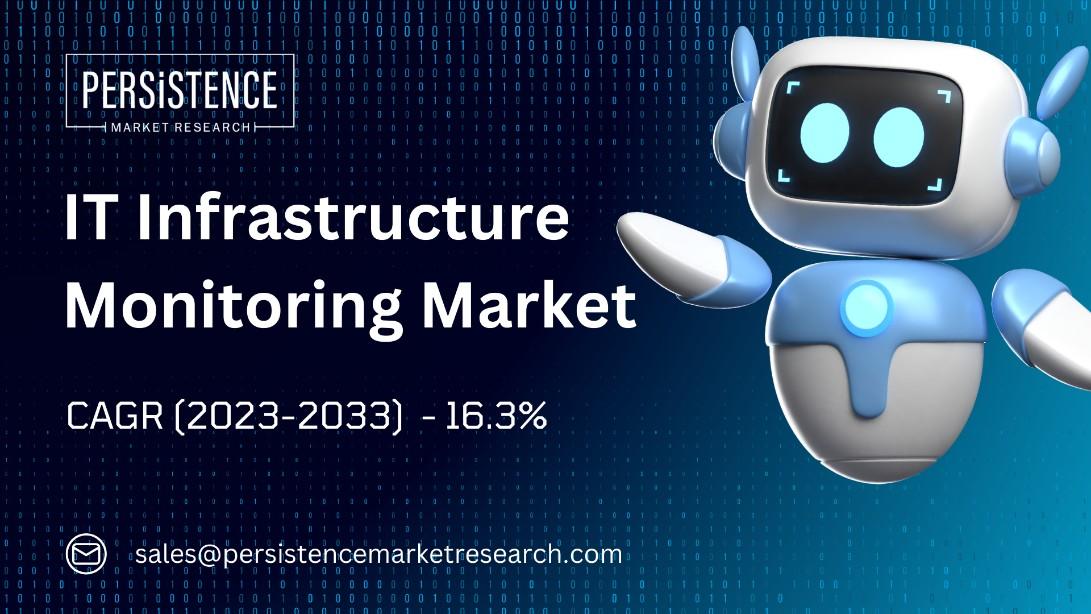IT Infrastructure Monitoring Market Set for Strong Growth over Next Decade
The IT infrastructure monitoring market was valued at USD 2,987.1 million in 2022 and is projected to reach USD 15,554.4 million by 2033, growing at a CAGR of 16.3% from 2023 to 2033. This growth is driven by rapid advances in programming, cloud computing, and AI integration, which enhance the adaptability and intelligence of IT systems. The market is expanding due to increased global IT infrastructure spending, though it faces potential slowdowns from rising cybersecurity threats. North America led the market with a 28.1% share in 2022, and Europe held about 19.1%. The software segment commanded 64.5% of the market, with the on-premise segment holding a 56.6% share in 2022. The market in India grew at 16.5% in 2022, reflecting strong regional growth.

Request for Sample: https://www.persistencemarketresearch.com/samples/8797
Introduction
The IT infrastructure monitoring market is poised for robust growth over the next decade, driven by rapid technological advancements and the increasing complexity of IT environments. As businesses continue to invest in digital transformation and modernize their IT infrastructure, the demand for sophisticated monitoring solutions is expected to surge. This article explores the factors contributing to the market's expansion, the emerging trends shaping its future, and the opportunities for growth in the coming years.
Market Outlook
Projected Growth
The IT infrastructure monitoring market is anticipated to experience significant expansion, with forecasts suggesting a strong upward trajectory through the next decade. The increasing reliance on digital technologies, coupled with the growing complexity of IT systems, is driving demand for advanced monitoring solutions that ensure operational efficiency, security, and compliance.
Key Factors Driving Growth
1. Technological Advancements: The rapid evolution of technologies such as artificial intelligence (AI), machine learning (ML), and the Internet of Things (IoT) is reshaping the IT
infrastructure monitoring landscape. These advancements enable more effective monitoring, predictive analytics, and automated issue resolution, driving the adoption of advanced monitoring solutions.
2. Digital Transformation: Organizations across industries are undertaking comprehensive digital transformation initiatives, leading to the modernization of IT infrastructures. As businesses adopt cloud computing, hybrid environments, and advanced technologies, the need for robust monitoring solutions to manage and optimize these complex systems becomes critical.
3. Increased IT Complexity: The growing complexity of IT environments, including the proliferation of cloud services, multi-cloud deployments, and the integration of IoT devices, requires advanced monitoring tools. These solutions are essential for managing performance, detecting issues, and ensuring security across diverse and interconnected IT systems.
4. Regulatory Compliance: Stricter regulatory requirements and industry standards are driving the need for continuous monitoring and reporting. Organizations must ensure compliance with various regulations, such as data protection laws and cybersecurity standards, further fueling the demand for comprehensive monitoring solutions.
5. Rising Cybersecurity Threats: The increasing frequency and sophistication of cyberattacks highlight the importance of effective monitoring for detecting and mitigating security threats. Organizations are investing in monitoring solutions to enhance their security posture and protect sensitive data from breaches.
Emerging Trends
Integration of AI and ML
Artificial intelligence and machine learning are transforming IT infrastructure monitoring by enabling predictive analytics, automated issue resolution, and enhanced data analysis. These technologies allow for more proactive monitoring, reducing the risk of downtime and improving overall system performance.
Cloud-Based Monitoring
The shift towards cloud computing is driving the demand for cloud-based monitoring solutions. Cloud-native tools offer scalability, flexibility, and cost-effectiveness, making them ideal for managing dynamic IT environments. As organizations increasingly adopt cloud services, cloud-based monitoring solutions will continue to gain prominence.
IoT and Edge Computing
The proliferation of IoT devices and the rise of edge computing are creating new challenges for IT infrastructure monitoring. Monitoring solutions are evolving to handle the data generated by IoT devices and ensure the performance and security of edge computing environments.
Enhanced Security Features
With growing concerns about cybersecurity, monitoring solutions are incorporating advanced security features. These include real-time threat detection, automated security patching, and comprehensive vulnerability assessments to protect IT systems from emerging threats.
